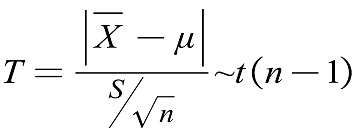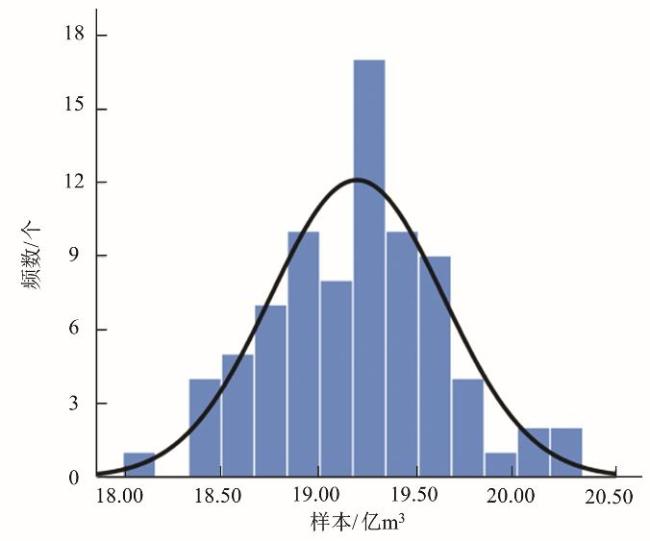 PDF(1275 KB)
PDF(1275 KB)


基于GA-BP神经网络与正态区间估计的需水预测——以邯郸市为例
马于航, 索梅芹
 PDF(1275 KB)
PDF(1275 KB)
基于GA-BP神经网络与正态区间估计的需水预测——以邯郸市为例
Research on Water Demand Forecasting in Handan City Based on GA-BP Neural Network and Normal Interval Estimation
科学准确的需水量预测结果可以为城市水资源供需平衡决策提供合理依据。针对城市需水涉及因素多、历史数据样本量少、需水量具有波动性和不确定性的特点,提出了基于GA-BP神经网络与正态区间估计的组合预测模型,模型使用主成分分析法、灰色关联分析法筛选影响因子,加入遗传算法优化BP神经网络,构建GA-BP神经网络,最后引入正态区间估计,输出需水量区间预测值,利用此模型对邯郸市2019年总需水量进行模拟预测,结果表明:单一使用GA-BP神经网络的点预测结果相对误差在-6.2%~5.13%之间;基于GA-BP神经网络和正态区间估计的组合预测模型的区间预测结果相对误差在-1.01%~0.004%之间,可见基于GA-BP神经网络与正态区间估计的组合预测模型更稳定、更准确,更接近邯郸市实际需水状况,该组合模型可作为邯郸市需水量预测的一种方法。
Scientific and accurate water demand prediction results can provide a reasonable basis for urban water supply and demand balance decisions. In this paper, a combined urban water demand forecasting model is proposed by incorporating GA-BP neural networks and normal interval estimation to address the problems of many factors involved in urban water demands, small sample sizes of historical data and fluctuation and uncertainty of water demands. The results show that the relative error of the point prediction results of a single GA-BP neural networks ranges from -6.2% to 5.13%; the relative error of the interval prediction results of the combined prediction model based on GA-BP neural networks and normal interval estimation ranges from -1.01% to 0.004%, which shows that the combined prediction model based on GA-BP neural networks and normal interval estimation is more stable, more accurate and closer to the actual water demand situation in Handan. The combined model can be used as a way to forecast the water demands in Handan.
GA-BP神经网络 / 正态区间估计 / 组合模型 / 区间预测 {{custom_keyword}} /
GA-BP neural networks / normal interval estimation / combined model / interval forecast {{custom_keyword}} /


表1 相关系数矩阵特征值及方差贡献率Tab.1 Eigenvalues and variance contribution of correlation coefficient matrix |
| 主成分 | 特征值 | 方差贡献/% | 累计贡献/% |
|---|---|---|---|
| 1 | 17.403 | 69.613 | 69.613 |
| 2 | 2.336 | 9.345 | 78.958 |
| 3 | 1.831 | 7.323 | 86.281 |
| 4 | 1.241 | 4.964 | 91.245 |
表2 主成分中指标的提取Tab.2 Extraction of indicators in principal components |
| 第一主成分 | 第二主成分 | 第三主成分 | 第四主成分 | |||||||
|---|---|---|---|---|---|---|---|---|---|---|
| 指标 | 特征向量 | 指标 | 特征向量 | 指标 | 特征向量 | 指标 | 特征向量 | |||
| X 4 | 0.238 511 | X 12 | 0.484 787 | X 1 | 0.410 192 | X 1 | 0.526 016 | |||
| X 24 | 0.238 032 | X 14 | 0.334 968 | X 14 | 0.331 849 | |||||
| X 20 | 0.237 313 | |||||||||
| X 19 | 0.235 875 | |||||||||
| X 7 | 0.233 717 | |||||||||
| X 17 | 0.230 601 | |||||||||
| X 6 | 0.230 361 | |||||||||
| X 15 | 0.229 402 | |||||||||
| X 25 | 0.228 204 | |||||||||
| X 21 | 0.226 286 | |||||||||
| X 8 | 0.225 567 | |||||||||
| X 22 | 0.225 088 | |||||||||
| X 16 | 0.222 930 | |||||||||
| X 5 | 0.215 979 | |||||||||
表3 灰色关联系数计算结果Tab.3 Calculation results of gray correlation coefficients |
| 指标 | 关联系数 | 指标 | 关联系数 | 指标 | 关联系数 | 指标 | 关联系数 | 指标 | 关联系数 |
|---|---|---|---|---|---|---|---|---|---|
| X 11 | 0.951 6 | X 14 | 0.879 7 | X 6 | 0.832 9 | X 8 | 0.782 8 | X 18 | 0.698 1 |
| X 12 | 0.950 5 | X 10 | 0.871 3 | X 21 | 0.824 6 | X 19 | 0.778 2 | X 7 | 0.687 2 |
| X 20 | 0.946 3 | X 3 | 0.860 1 | X 15 | 0.821 0 | X 4 | 0.772 8 | X 22 | 0.651 1 |
| X 1 | 0.934 3 | X 2 | 0.856 3 | X 5 | 0.805 6 | X 25 | 0.771 2 | X 23 | 0.628 5 |
| X 9 | 0.931 4 | X 17 | 0.837 4 | X 24 | 0.785 4 | X 16 | 0.734 2 | X 13 | 0.624 3 |

图3 BP神经网络和GA-BP神经网络模拟预测结果Fig.3 BP neural network and GA-BP neural network simulation prediction results |
表4 BP神经网络和GA-BP神经网络模拟预测结果统计 (%)Tab.4 Statistics of simulation prediction results of BP neural network and GA-BP neural network |
| 相对误差 | 农业用水 | 工业用水 | 生活用水 | 总用水 | ||||
|---|---|---|---|---|---|---|---|---|
| BP | GA-BP | BP | GA-BP | BP | GA-BP | BP | GA-BP | |
| 训练样本最大相对误差 | 6.59 | 7.64 | 8.96 | 3.50 | 16.22 | 8.85 | 3.17 | 3.29 |
| 检验样本最大相对误差 | 2.37 | 1.85 | 4.76 | 2.38 | 4.12 | 1.87 | 4.69 | 2.84 |
| 训练样本平均相对误差 | 1.22 | 1.79 | 2.00 | 0.78 | 1.69 | 1.62 | 1.24 | 0.85 |

图4 GA-BP神经网络2019年总需水量点预测结果频率分布Fig.4 Frequency distribution of GA-BP neural network 2019 total water demand point forecast results |
表5 GA-BP神经网络2019年总需水量点预测结果描述统计Tab.5 GA-BP neural network 2019 total water demand point forecast results descriptive statistics |
| 样本 | 真实值/亿m3 | 模拟值 | |||||
|---|---|---|---|---|---|---|---|
| 最小值/亿m3 | 相对误差/% | 最大值/亿m3 | 相对误差/% | 平均值/亿m3 | 标准差 | ||
| 80 | 19.278 4 | 18.082 4 | -6.2 | 20.266 6 | 5.13 | 19.18 | 0.44 |
表6 基于GA-BP神经网络与正态区间估计的2019年总需水量区间预测结果Tab.6 Total water demand interval forecast results for 2019 based on GA-BP neural network with normal interval estimation |
| 邯郸市2019年总需水量/亿m3 | 区间预测(95%置信度) | |||
|---|---|---|---|---|
| 下限/亿m3 | 相对误差/% | 上限/亿m3 | 相对误差/% | |
| 19.278 4 | 19.083 4 | -1.01 | 19.279 2 | 0.004 |
| 1 |
刘广奇,雷木穗子. 城市供水规划决策支持系统研究与应用[J]. 中国给水排水,2020,36(13):124-129.
{{custom_citation.content}}
{{custom_citation.annotation}}
|
| 2 |
贾香香. 泉州市城镇居民综合生活需水预测方法研究[J]. 水资源开发与管理,2020(3):52-55,48.
{{custom_citation.content}}
{{custom_citation.annotation}}
|
| 3 |
刘 鑫,桑学锋,常家轩,等. 基于聚类分析的滑动时均序列需水预测优化方法[J]. 中国农村水利水电,2021(9):199-205.
{{custom_citation.content}}
{{custom_citation.annotation}}
|
| 4 |
张少杰,游 洋. 基于主成分回归分析的需水预测研究[J]. 海河水利,2016(3):43-45,56.
{{custom_citation.content}}
{{custom_citation.annotation}}
|
| 5 |
吴泽宁,张海君,王慧亮. 基于不同预测方法组合的郑州市工业需水量评价[J]. 水电能源科学,2020,38(3):46-48.
{{custom_citation.content}}
{{custom_citation.annotation}}
|
| 6 |
{{custom_citation.content}}
{{custom_citation.annotation}}
|
| 7 |
李振全,徐建新,邹向涛,等. 灰色系统理论在农业需水量预测中的应用[J]. 中国农村水利水电,2005(11):24-26.
{{custom_citation.content}}
{{custom_citation.annotation}}
|
| 8 |
{{custom_citation.content}}
{{custom_citation.annotation}}
|
| 9 |
王韶伟,许新宜,贾香香,等. 基于灰色动态模型群的需水预测研究[J]. 中国农村水利水电, 2010(2):29-31.
{{custom_citation.content}}
{{custom_citation.annotation}}
|
| 10 |
孙晓婷,刘年东,杜 坤,等. 混沌局域法与神经网络组合供水量预测[J]. 土木建筑与环境工程,2017,39(5):135-139.
{{custom_citation.content}}
{{custom_citation.annotation}}
|
| 11 |
管桂玲,卢发周,果利娟,等. 基于组合预测法的城市需水预测[J]. 江苏水利,2019(3):6-8,16.
{{custom_citation.content}}
{{custom_citation.annotation}}
|
| 12 |
郭 华,郑 侃,林占东,等. 粒子群算法在城市需水预测模型中的应用[J]. 中国农村水利水电,2008(12):63-65.
{{custom_citation.content}}
{{custom_citation.annotation}}
|
| 13 |
马兴冠,傅金祥,李 勇. 水资源需求预测研究[J]. 沈阳建筑工程学院学报(自然科学版),2002(2):135-138.
{{custom_citation.content}}
{{custom_citation.annotation}}
|
| 14 |
聂红梅,赵建军,李兴菊,等. 城市需水预测算法比较[J]. 软件导刊,2019,18(10):69-73.
{{custom_citation.content}}
{{custom_citation.annotation}}
|
| {{custom_ref.label}} |
{{custom_citation.content}}
{{custom_citation.annotation}}
|
 PDF(1275 KB)
PDF(1275 KB)
 图1 组合模型设计
图1 组合模型设计 图2 BP神经网络基本结构
图2 BP神经网络基本结构 表1 相关系数矩阵特征值及方差贡献率
表1 相关系数矩阵特征值及方差贡献率 表2 主成分中指标的提取
表2 主成分中指标的提取 表3 灰色关联系数计算结果
表3 灰色关联系数计算结果 图3 BP神经网络和GA-BP神经网络模拟预测结果
图3 BP神经网络和GA-BP神经网络模拟预测结果 表4 BP神经网络和GA-BP神经网络模拟预测结果统计 (%)
表4 BP神经网络和GA-BP神经网络模拟预测结果统计 (%) 图4 GA-BP神经网络2019年总需水量点预测结果频率分布
图4 GA-BP神经网络2019年总需水量点预测结果频率分布 表5 GA-BP神经网络2019年总需水量点预测结果描述统计
表5 GA-BP神经网络2019年总需水量点预测结果描述统计 表6 基于GA-BP神经网络与正态区间估计的2019年总需水量区间预测结果
表6 基于GA-BP神经网络与正态区间估计的2019年总需水量区间预测结果/
| 〈 |
|
〉 |